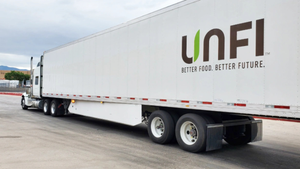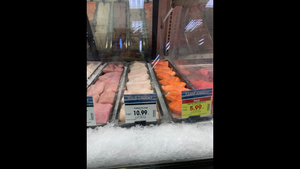Technology Helps Kroger Keep Fast-Checkout Promise
It is an article of faith in the food retailing industry that one of the key drivers of customer satisfaction is a positive checkout experience, which generally translates into spending as little time as possible in line. While all retailers aspire to this ideal, how can Kroger actually promise shoppers they will spend less time in line?
April 30, 2012
 “I’m committed to getting my customers through the lines quicker,” says a Kroger cashier in a commercial posted on YouTube. Other cashiers chime in: “At Kroger you get shorter lines and faster checkouts. Who likes standing in line? We promise you will spend less time in line. Faster checkout at Kroger [repeated].”
“I’m committed to getting my customers through the lines quicker,” says a Kroger cashier in a commercial posted on YouTube. Other cashiers chime in: “At Kroger you get shorter lines and faster checkouts. Who likes standing in line? We promise you will spend less time in line. Faster checkout at Kroger [repeated].”
It is an article of faith in the food retailing industry that one of the key drivers of customer satisfaction is a positive checkout experience, which generally translates into spending as little time as possible in line. While all retailers aspire to this ideal, how can Kroger actually promise shoppers they will spend less time in line?
To deliver on that promise, the Cincinnati-based company, the nation’s largest traditional food retailer, has invested in various kinds of POS technology aimed at improving the checkout experience. Though Kroger would not comment for this article, its activities at the checkout have left a considerable paper and digital trail, reflecting the retailer’s focus on the shopper experience, one of the four key elements (with price, products and people) that make up its vaunted “customer first” philosophy.
At a base level, Kroger’s front-end checkout technology is a retail-hardened system from IBM: ACE software running on SurePOS 700 terminals with the 4690 operating system, according to IHL Consulting Group, Franklin, Tenn., which tracks retailers’ IT investments. (IBM recently sold its POS business to Toshiba TEC.)
Customers in Charge: A Special SN Edition
With this sturdy front-end foundation, Kroger has taken to experimenting, particularly on the self-checkout side. For example, the retailer has attracted a lot of attention with a self-checkout “tunnel” system, which has been tested in a store in Hebron, Ky., since 2010. The tunnel, which contains a dozen cameras that read bar codes from any direction, moves products about three times as fast as a conventional checkout, and can scan a cart of groceries in under a minute, the company said.
In some other northern Kentucky stores, Kroger is trying out self-scanning handheld devices that consumers can use to scan and bag their purchases as they traverse the store. Kroger’ acknowledged that its strategy is to master a personal shopping platform under its control to get a leg up on the emerging world of smartphone apps.
Tracking Shoppers
But Kroger’s biggest IT play has been to improve the speed of its conventional lanes, backing up its “faster checkout” pledge. The most noticeable example of that is what Kroger calls the QueVision system, which tracks the number of shoppers in the store and at checkouts, and signals the need to open up additional checkouts to accommodate them. According to a recent article in the Dallas Morning News, Kroger’s QueVision system was installed in all Kroger stores at the end of last year.
The QueVision queue management system is described on the website of Irisys (irisys.co.uk), the U.K.-based company (with U.S. offices in Atlanta) that markets the technology. Though Irisys declined to comment on its involvement with Kroger, its website includes Kroger among its retail customers, along with U.K. grocers Tesco and Morrisons.
Irisys’s queue management system includes a “people counter” above each entrance/exit that tabulates the number of people entering and leaving the store by using heat-sensitive infrared sensors. The system also features infrared sensors above the checkout lanes that can detect the number of “units” of shoppers — a unit could include a mom and two kids — in line, and their average wait time.
The system then crunches the data gleaned from the sensors to predict the number of lanes that should be open in 15 minutes, and in 30 minutes, to maintain the retailer’s customer service standard at the checkout. (This could mean opening or closing lanes.)
According to a case study posted by Visual8, Mississauga, Ontario, on its website (www.visual8.com), Kroger has set a “1 2” checkout criteria, by which there should be at most two parties waiting to be served at a lane (in addition to the one currently being served).
Supermarkets Expand Relationships on Facebook
The direction for lane openings can be displayed on a handheld terminal or on a monitor; in Kroger’s case, it’s shown on a monitor posted near the checkout area. Kroger’s screen displays three balls showing the number of lanes open, the number needed to be opened now and the number that should be opened in 30 minutes.
The queue management system also populates a manager’s dashboard with reports on traffic and service compliance levels. It can be used to supplement labor scheduling software that forecasts labor requirements, and to support the Reflexis task management application.
“It’s quite sophisticated on the advance notice it can give for a schedule the checkout team can use,” said a Morrisons’ executive interviewed on a YouTube video. Tesco employs the system to support its “one-in-front” promise, which is that if there is ever more than one person in line the retailer “would do its best” to open up another checkout. Tesco said its “internal measures” indicate waiting time has been reduced by the system.
Another technology Kroger has employed in recent years to improve checkout service is a “storefront simulation tool” developed by Visual8. According to the Kroger case study on the Visual8 website, the tool is able to analyze the impact of different checkout configurations — regular and express checkout lanes as well as self-checkouts — with changing staffing and customer demand profiles. Additional inputs include processing times at regular and express checkout lanes based on Kroger standards.
In leveraging the simulation tool, Kroger provided data on customer traffic, arrival times, sales volume, and payment type to Visual8, which did the analysis, said Paul Jarvis, senior simulation consultant for Visual8.
Ultimately, the tool allowed Kroger to identify possible process improvements at customer checkout and to make recommendations on the design and layout of new or remodeled storefront operations. The objective, noted Jarvis, was to speed up checkout. Details of the improvements were not provided.
About the Author
You May Also Like






